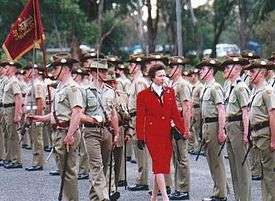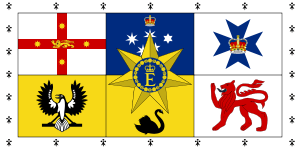Australian royal symbols
A number of royal symbols exist in Australia, reflecting the country's status as a constitutional monarchy. These include symbols of the monarch of Australia, as well as the monarch's Vice-regal representatives.
Despite the removal or replacement of certain monarchical symbols in recent history, as well as the fact that the Royal Family is not resident in Australia itself, the Crown remains a visible part of the everyday lives of Australians. A number of symbols of the monarchy are based on British heraldry, such as the Royal Coat of Arms of Australia, though these have been adapted with purely Australian symbols, and what were formerly purely British symbols have become symbols of the monarch, or loyalty thereto. Use of the royal Crown is granted by Royal Proclamation, and through royal patronage, certain organizations may also have or use royal symbols. Many organizations in Australia that have been granted a Royal prefix often incorporate royal symbols into their imagery.
Images of the sovereign

Coinage and postage
The reigning monarch's image is traditionally printed on Australian coins, some currency and postage stamps such as the Queen Elizabeth II definitive stamp. Coins bear an effigy of the monarch as the function of currency to serve as a readily accepted medium of exchange rests on the state being a guarantor of the money's value, and the sovereign is the personal representation of the state itself. Produced by the Royal Australian Mint, all coins portray Queen Elizabeth II on the obverse, with the present effigy having been designed by Ian Rank-Broadley.
Artworks
Though images of sovereigns have been present in the country since Australia was first settled by Europeans, only in the past century have Australia's royals been portrayed by Australian artists. The official portrait of Her Majesty was painted by Sir William Dargie, although other Australians, namely Rolf Harris, have also painted portraits.
Portraits of the monarch are often found in government buildings (most notably Local Council Chambers), military installations, some schools, as well as Australia's High Commissions and Embassies abroad.
The Crown is used as a heraldic symbol in the coats of arms of the Commonwealth and the states of Victoria, Queensland and Western Australia. Likewise it is used in the state flags of Victoria and Queensland.
The Coat of arms of Australia (or more rarely an image of the Queen) is displayed in Australian federal courtrooms. In a practice dating back to colonial times, state courts traditionally display the personal arms of the sovereign (those currently used by the sovereign in right of the United Kingdom); however in Queensland courtrooms, and some of those in New South Wales and Victoria, the state arms have replaced these arms.
Flags
The Queen's Personal Australian Flag is the symbol of the Australian monarch, and takes precedence over all other Australian flags, including the National flag. Second in precedence is the personal flag of the Governor-General, followed by the flags of the State Governors.
Verbal and musical symbols
"God Save the Queen" is Australia's Royal Anthem. Due to a contemporaneous mistake in the Government Gazette, it is sometimes thought that the Royal Anthem can only be played in the presence of the Queen. The official Vice-Regal Proclamation, however, makes no such order, meaning the Anthem may be played by Australians to commemorate any occasion. In addition to the Royal Anthem, "Advance Australia Fair" has been adopted as the national anthem, both by proclamation of Governor-General Sir Ninian Stephen, on 19 April 1984.[1] The Vice-Regal Salute, played only for the Governor-General and each state Governor, is the first four and last four bars of "Advance Australia Fair".
In March 2006 organisers of the 2006 Commonwealth Games in Melbourne came under fire when it was announced that they would not play "God Save the Queen" at the ceremonies where the Queen was to open the Games. Despite the fact that the song is officially the Royal Anthem of Australia, to be played whenever the sovereign is present, the games organisers refused to play it. After repeated calls from Prime Minister John Howard, organisers agreed to play eight bars of the Royal Anthem at the opening ceremony. However, there remained speculation that the opening of the games could be "thrown into chaos" should thousands of Australians continue to sing "God Save the Queen" after the eight bars were complete, drowning out singer Dame Kiri Te Kanawa and the Melbourne Symphony Orchestra. In the end, with the crowd singing along, Dame Kiri sang Happy Birthday to the Queen, the rendition of which then turned into an abbreviated God Save the Queen, and at which point the majority of attendees at the stadium stood.
A Loyal Toast is also performed at official functions whether or not the sovereign is personally present; it consists of a toast to the health of Her Majesty the Queen, and is usually performed by the host or guest of honour at the ceremony, aside from the Queen herself. In English the toast is: "Ladies and gentlemen, The Queen of Australia".
Sessions of the High Court of Australia are opened with the words "the High Court of Australia is now in session; God Save the Queen."
Previously, the Oath of Citizenship contained a statement of allegiance to the reigning monarch. Since 1994, however, new Australian citizens have taken a pledge of allegiance to Australia and its values only. Under Australian nationality law the Queen is not an Australian citizen; but neither is she an alien. As Queen she in a category sui generis.
The Constitution of Australia requires all Members of the Commonwealth Parliament to swear an oath or make an affirmation of allegiance to the sovereign.[2]
In the states all parliamentarians of the Legislative Assemblies and Councils (excepting Queensland which is unicameral) swear an oath in the name of the monarch. In the courts all Magistrates, Judges and Justices of the Peace swear in the name of the Queen
Calendar dates
- 6 February is recognised as the anniversary of the Queen's Accession to the Throne
- the Queen's Birthday is observed as a public holiday in all states, however it is not celebrated on her actual birthday, 21 April. The date of the public holiday varies from state to state.
- 2 June is recognised as the anniversary of the Queen's Coronation
- 10 June is recognised as the birthday of Prince Philip, Duke of Edinburgh
- 14 November is recognised as the birthday of Charles, Prince of Wales
- On Christmas Day each year since 1932, the sovereign has delivered the Royal Christmas Message to the Commonwealth of Nations; originally broadcast on the BBC Empire Service.
Honours and decorations

Images of St. Edward's, the Tudor, and King's Crown are visible on police forces badges (see New South Wales Police badge), military badges, some state (see Coat of Arms of Western Australia), even personal coats of arms (see Crest of Sydney Boy's High School), on Australia's Royal Coat of Arms and on various Australian decorations and honours. These include the vestments of the Order of Australia
These latter cases reflect the monarch's place as the ceremonial head of the Australian honours system, termed the fount of honour. As such, only she can approve the creation of an honour, which she does as requested by government of Australia. Although, the Governor-General administers most responsibilities relating to Australian honours on the Queen's behalf.
Geographic names
There are hundreds of places named after Australian monarchs and members of the Royal Family. The states of Queensland and Victoria were named after Queen Victoria; Adelaide, the capital of South Australia is named after Queen Adelaide, the consort of William IV; the township of Elizabeth, also in South Australia, is named after the present sovereign. Numerous streets, squares, parks and buildings are also named in honour of past or present members of the Royal Family.
Royal presence

The monarch or a deputed member of the Royal Family may represent Australia abroad or with its territory. For example, the Queen, Prince Charles, and Princess Anne have participated in Australian ceremonies for the anniversary of D-Day in France, most recently in 2004.
The Queen has toured Australia to celebrate Australian culture, milestone anniversaries, military remembrances, and the like. Other royals will perform the same tasks in the Queen's place, from time to time. These tours are at the invitation of, organised, and paid for by the Australian Government, a State Government, or a combination of both; hence, they are called official tours or official visits.[3]
Members of the Royal Family have presided over military ceremonies, including Trooping of the Colours, inspections of the troops, and anniversaries of key battles. Whenever the Queen is in Canberra she lays a wreath at the Australian War Memorial. Elizabeth II acted in her capacity as Queen of Australia abroad in 2003 when she dedicated the Australian War Memorial in Hyde Park, London.
Military honours
A number of members of the Royal family also hold and have held several distinctions as part of the Australian Defence Forces:
Living;
- HM Queen Elizabeth II:
- Captain-General of the Royal Regiment of Australian Artillery (1953–Present)
- Colonel-in-Chief of the Royal Australian Engineers (1953–Present)
- Colonel-in-Chief of the Royal Australian Infantry Corps (1953–Present)
- Colonel-in-Chief of the Royal Australian Army Ordnance Corps (1953–Present)
- Colonel-in-Chief of the Royal Australian Army Nursing Corps (1953–Present)
- Air-Commodore-in-Chief of the Australian Citizen Air Force (1953–Present)
- HRH Prince Phillip, Duke of Edinburgh:
- Field Marshal of the Australian Army (1954–Present)
- Colonel-in-Chief of the Royal Australian Electrical and Mechanical Engineers (1959–Present)
- Colonel-in-Chief of the Australian Army Cadets (1970–Present)
- Marshal of the Royal Australian Air Force (1954–Present)[4]
- Admiral of the Fleet of the Royal Australian Navy (1954–Present)
- HRH The Prince of Wales:
- Colonel-in-Chief of the Royal Australian Armoured Corps (1977–Present)
- HRH Princess Anne, Princess Royal:
- Colonel-in-Chief of the Royal Australian Corps of Signals (1977–Present)
- Colonel-in-Chief of the Royal Australian Corps of Transport (2004–Present)
- Colonel-in-Chief of the Australian Army Intelligence Corps
- HRH The Duchess of Gloucester:
- Colonel-in-Chief, of the Royal Australian Army Education Corps
- Deceased
- HM King George VI (1895-1952):
- Marshal of the Royal Australian Air Force (1939-1952)
- HRH Princess Mary, Princess Royal (1897-1965):
- Colonel-in-Chief of the Royal Australian Corps of Signals (1937-1965)
- HRH Princess Margaret, Countess of Snowdon (1930-2002):
- Colonel-in-Chief of the Women's Royal Australian Army Corps (1953-1985)
- HRH The Duchess of Gloucester (1901-2004):
- Colonel-in-Chief of the Royal Australian Corps of Transport (1977-2004)
References
- ↑ Commonwealth of Australia Gazette; No. S 142; 19 April 1984
- ↑ Schedule to the Australian Constitution Archived September 4, 2008, at the Wayback Machine.
- ↑ Buckingham Palace: Guidelines and Procedures for the Acceptance, Classification, Retention and Disposal of Gifts to Members of the Royal Family
- ↑ Duke of Edinburgh
